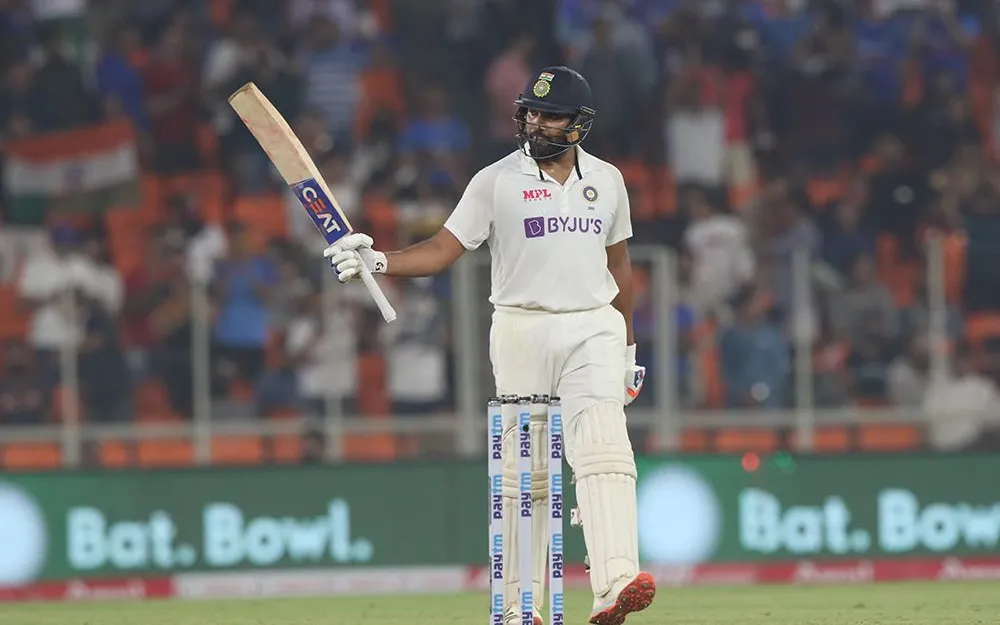Rohit Sharma’s transformation as a Test batsman now calls for thorough respect
Back in 2013, when Rohit Sharma made his debut in the Indian whites, the question was how long before he could transform himself into the batsman that was hailed as the best in domestic cricket. It is 2021, and that transformation has finally been complete and now calls for respect.

When Rohit Sharma was awarded the Indian cap in the longest format, it was announced that a superstar, a next-generation world-beater had arrived and it came four years after he was first in line for a Test debut. Right in his first innings, battling the familiar heat and conditions in Mumbai, at the Wankhede, Rohit scored a colossal 177 off 301 deliveries, standing under the sun for nearly 370 minutes. Rohit had arrived, the superstar, not quite yet.
Six years had passed since then, Rohit had already established himself as a world-beater in the white-ball format but in Tests, his ultimate Test was always around the corner and when he seemingly had passed one, another one was right there. Such was his start to his red-ball career, that questions left-right-centre were raised over how he was another ‘over-rated’ flat-track bully. The entire argument around it stemmed from the series mauling against South Africa at home.
Coming into the 2019 home season, Rohit had played 27 Tests, a high score of 177 on a tough surface but never quite translated his form into a place, a place into a statement and a statement into a known fact. South Africa was supposed to be a litmus test, he passed it with flying colours yet the name ‘flat-track bully stuck with him, for scoring centuries at home, something that all batsmen are supposed to do, nothing dramatic here.
But when the discussion prevails around Rohit, it becomes a national-debate, slowly gets converted into a multi-platform international one and slowly into an issue that the United Nations probably might have to look at. His 176, 127 and the 212 in Ranchi, all slowly became just numbers on the wall and nothing more than that. Rohit could do it in India, on day one and two surfaces, which won’t aid the bowlers but can he do it elsewhere? Can he summon up the demons on his side?
His twin failure, scores of 6 and 21 - certainly painted a different picture and people immediately jumped, like they wanted to see the end of him. Rohit against the moving ball, Rohit against the spinning ball - the questions were aplenty and every time he walked out - the metric and the bar raised every time. He wasn’t compared to other batsmen in the country, he was compared to India’s best batsman at home - Virat Kohli; he was compared to India’s best in overseas conditions - Cheteshwar Pujara.
When it came to his selection in Australia, it became a controversy of its own and the expectations continued to rise. As time and again, he has, Rohit continued to shoo off all the criticism, be it with his batting, his ability to lead the team (in a limited ability) or be it his involvement in the Test setup. Rohit wasn’t a teenager anymore, he wasn’t another talented cricketer anymore, he was a leader, he led the team, he led the opinions - everything that was required in the Indian setup.
While he only scored 26 and 52, the way he dealt the Australian new-ball attack was pretty impressive. Having played two Tests less than anyone on the tour, Rohit was already considered as one of the best openers in the series. His involvement in the game, the proactive part of it made the 33-year-old once again relevant, not on the list of openers but on the list of great batsmen to have played for India. He didn’t want that petty genuine talent tag around him, he sought respect, he had earned it, by now!
The trolls and barns that associated with him, the tag of being called a ‘Maggi’ guy, to being ridiculed for his weight, to his talent, to his Test form, Rohit had by now, suffered the toughest yards of his cricketing career when other countries would have GOATed him. While the 33-year-old won’t get the fans out of their coach, in awe, in shock, in surprise - he has made them all stand up and applaud with respect, this series.
While against South Africa, he was dominating, he took on the spinners and left an indelible mark, here against England, he wasn’t fighting for a place in the side but fighting for the respect that he had by now, earned! Every time he steps out now, there is a definite and different version of him - cool, calm, composed one day and an aggressive batsman, the other.
"I've never understood why it's debated so much. People keep talking about it, but the fact is this is how pitches in India have been for a long time. I don't think anything should change. Everyone makes use of the home advantage. When we go outside, no one thinks about us - so why should we think of others?” Rohit said after the third Test.
Since his second innings in the Indian setup, in 2018, the focus despite being on his form was always on was he dedicating himself to the longest format, yet. Because until then, his fitness, his status and his consistency were under the scanner. After the IPL final, where he went out and played for Mumbai Indians, the focus was on him again - did he put his club over the country? In fact, Rohit cares about cricket, club or international level, he goes out, swinging and playing the same way.
As determined he was making an appearance for Mumbai - he was waiting for his time, before facing the Australian bowlers in Sydney. He was determined to make an effort and the three failures that preceded his 161, was once again under the scanners. Now, he’s not just another opener in the setup but one that brings about a lot of value in the country. More than ever, it is time for us to respect him, his transformation that has thoroughly sought respect.
Rohit Sharma is playing assertively, but with control. His attacking shot percentage (26%) is above the average for the match, but his false shot percentage (14%) is lower than average for the match. #INDvENG
— The CricViz Analyst (@cricvizanalyst) February 24, 2021
Against England, he didn’t face spinners as much as he faced the pacers but whenever the spinners were operating, it wasn’t easy, it wasn’t a child’s job on a pitch where everyone suffered. The entire Indian team was dismissed for 145, he stood out there, scoring 66, off 96 deliveries, at a strike-rate of nearly 70. When boundaries were tough to get, he got eleven of them and when leadership was needed from the batsmen, he showed all the signs of that.
In the last three Tests, Rohit has scored 132 runs off 163 deliveries, against one of the best pace units in World Cricket, at a strike-rate of 80.98 with just one dismissal. But more importantly, time and again, he showed the other batsman how to play on such surfaces, under lights, or without lights, when there was support for the pacers, or when there wasn’t any. It wasn’t any easy surface for anyone, Kohli called it tough but insisted that batsmen didn’t quite trust their defence.
For Rohit, it was just his way of showing his value in the Indian test unit, it was his form of telling the entire world that he belonged at the highest level. It was his way of calling for thorough respect, it was his way of showing that trolls, outside noise, criticism barely affected him. This series would always be known for the Indian spinners, who in between them, might even walk away with 40-50 wickets in the series but Rohit, the batsman, the leader and more importantly, the talent, would be known for deserving the respect.

Comments
Sign up or log in to your account to leave comments and reactions
0 Comments